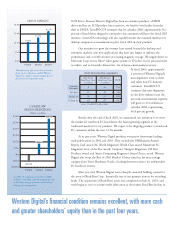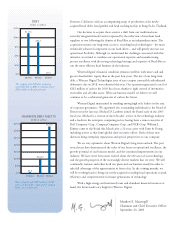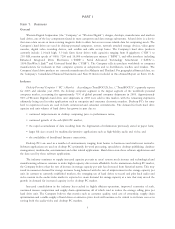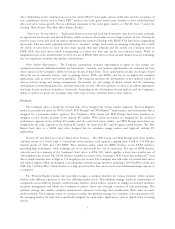Western Digital 2003 Annual Report Download - page 14
Download and view the complete annual report
Please find page 14 of the 2003 Western Digital annual report below. You can navigate through the pages in the report by either clicking on the pages listed below, or by using the keyword search tool below to find specific information within the annual report.In 2003, the top seven desktop personal computer manufacturers accounted for approximately 49% of all shipments
of desktop PC's in the desktop PC market. As a result, maintaining customer satisfaction with these leading computer
manufacturers is critical.
Computer manufacturers evaluate and select their hard drive suppliers based on a number of factors, including
overall quality, storage capacities, performance characteristics, price, service and support, ease of doing business, and the
supplier's long-term Ñnancial stability. They typically seek to qualify two or three providers for each generation of hard
drives, and once a computer manufacturer has chosen its qualiÑed hard drive vendors for a given product, it generally will
purchase hard drives from those vendors for the life of that product. To achieve success with computer manufacturers'
qualiÑcations, a hard drive supplier must consistently oÅer hard drives featuring leading technology, quality and high
capacity per disk. Suppliers must quickly achieve volume production of high quality and reliable hard drives. To quickly
achieve high volume production, a hard drive supplier must have access to Öexible, high-capacity, high-quality
manufacturing capabilities.
Many of the Company's computer manufacturer customers (also referred to as original equipment manufacturers or
""OEMs'') have adopted just-in-time inventory management processes or supply chain business models that combine
""build-to-order'' (computer manufacturer does not build until there is a Ñrm order) and ""contract manufacturing''
(computer manufacturer contracts assembly work to a contract manufacturer who purchases components and assembles
the computer based on the computer manufacturer's instructions). For certain key OEMs the Company maintains a base
stock of several weeks, on average, of current, Ñnished goods inventory in facilities located adjacent to the OEM's
operations. Inventory at these locations usually includes minor product customizations (such as labeling) for the related
computer manufacturer. If subsequent to its initial order the computer manufacturer changes its requirements, inventory
held at these facilities can be sold to other computer manufacturers or distributors ""as is'' or with minor modiÑcations
(such as a change in labeling) at little or no additional cost. Therefore, changes in an OEM's requirements have minimal
impact on inventory valuation.
For an additional discussion of the need to adapt to customers' business models and maintain customer satisfaction,
refer to Part II, Item 7, under the headings ""Risk Factors That May AÅect Future Results.''
Distributors. The Company uses a select group of distributors to sell its products to small computer manufacturers,
resellers, dealers and systems integrators. During 2003, the Company's major distributor customers included ASI,
Digiland, eSys Distribution, Ingram Micro, Tech Data and TSR Silicon Resources. Distributors accounted for
approximately 40%, 39% and 45% of the Company's revenue for 2003, 2002 and 2001, respectively. Distributors
generally enter into non-exclusive agreements for speciÑc territories with the Company for purchase and redistribution of
product on a quick turnover basis. Blanket purchase orders are placed on a quarterly basis and shipments are made based
upon a distributor's weekly authorization. The Company grants its distributors price protection, and certain distributors
have limited rights to return product on an inventory rotation basis.
Retailers. The Company sells its retail-packaged products directly to a select group of major retailers such as
computer superstores, warehouse clubs and computer electronics stores, and authorizes sales through distributors to
smaller retailers. During 2003, major retailers to whom the Company sold directly included Best Buy, Circuit City,
CompUSA, Fry's Electronics, OÇceMax and Sam's Club. Retailers accounted for approximately 8%, 7% and 7% of the
Company's revenue for each of 2003, 2002 and 2001, respectively. The Company's current retail customer base is
primarily in the United States, Canada and Europe. The retail channel complements the Company's other sales channels
while helping to build brand awareness for the Company and its products. Retailers supply the aftermarket ""upgrade''
sector in which end-users purchase and install products to upgrade their computers. The Company grants certain of its
retailers price protection and limited rights to return product on an inventory rotation basis. The Company also sells its
retail-packaged products through the Internet, at its web site.
The Company maintains sales oÇces throughout North America, Eastern and Western Europe, the Middle East,
Japan and Asia/PaciÑc. Field application engineering is provided to strategic computer manufacturer accounts, and
localized end-user technical support services are provided within the United States, Canada and Europe. The Company's
localized end-user technical support is currently supplied by employees and a third party provider through telephone
support, and via the Company's web site.
8
























